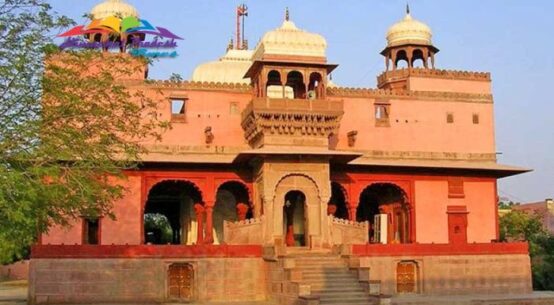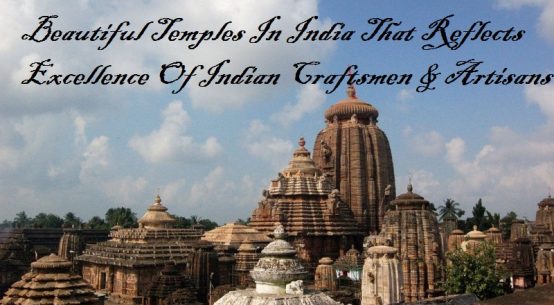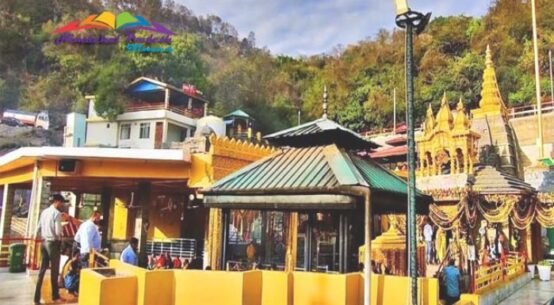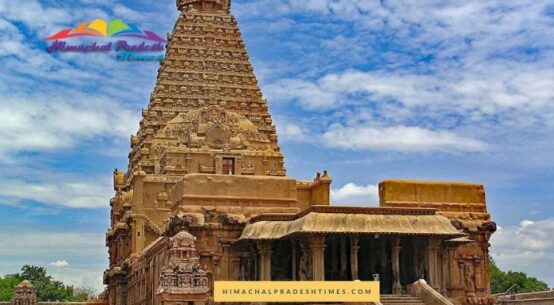In the Indian state of Himachal Pradesh, the city of Una houses the ancient Hindu temple called Shiv Bari Temple. It is a popular site for pilgrims to pay homage to Lord Shiva. It is held in esteem by the locals as being amongst the most notable temples around. The placement of the temple on the bank of the Swan River adds to its peaceful environment.
The temple, ringed by a high wall, draws tourists with its peaceful and respectful ambience. Here you will find a beautiful wall painting of the Nandi Bull. This is the 1st thing that will attract your attention. When you step inside the temple, you will be greeted by a captivating mural of the Nandi Bull looking worshipfully at the Shiva Lingam. This is the beginning of an intensely immersive experience.
Shiv Bari Temple’s Architecture
The architecture of the temple is stunning, featuring intricately designed pavilions, domes, and intricate columns that accentuate the excellent craftsmanship of the past. The Lord Krishna and “Gopis” statues on the grounds surrounding the temple give a divine beauty to the space and mesmerise the faithful with their grace.
Most people regard the Shiv Bari Temple as a place where one can truly experience a connection to his or her spirituality, and travellers often come back with tales of feeling perfectly calm and serene in the presence of the temple. Its peaceful retreat from the city hubbub is made even greater by its seclusion.
History of Shiv Bari Temple
The Shiv Bari temple’s history spans as far back as the sixteenth century. King Sahil Varman, who was the ruler of the region during that period, is said to have erected the shrine. The temple architecture is a blend of Hindu and Islamic themes with intricate patterns, stunning artworks, and stone carvings. There are also many more temples dedicated to various gods that constitute the large temple complex. The central worship centre is the beautiful Shiva Lingam in the main temple. A symbol of the power of Lord Shiva, the Shiva Lingam is believed to bring prosperity and good luck to its believers.
The people here give immense importance to this temple. Also, throughout the year, a large number of devotees from outside the temple come here. Especially when there is an annual fair here in February and March. During these months, people beautifully decorate the temple with flowers and lights, and they organize various cultural programs. Worshippers can spend their time surrounded by the devotional atmosphere and seek the blessings of Lord Shiva during the entire fair.
Religious Significance of Shiv Bari Temple
For devotees of Lord Shiva, the Shiv Bari Temple is more than just an architectural wonder; it holds deep spiritual importance. The temple draws thousands of pilgrims each year, thanks to its powerful spiritual energy, as reported by various sources. Many devotees perform special prayers and rituals, especially on Mondays, which are considered auspicious for worshipping Lord Shiva. Additionally, the temple serves as a key location for Mahashivratri celebrations, featuring grand pujas and bhajans that leave a lasting impression on visitors.
Another significant feature of the temple is the sacred water tanks, where devotees bathe before offering their prayers. It is believed that bathing in these waters brings prosperity and purifies the soul.
How To Reach Shiv Bari Temple
To reach Shiv Bari Temple, you can fly to the nearest airport in Chandigarh, which is about 120 kilometres away. From the airport, you can take a bus or a taxi to Una. Since Una is well-connected to major cities in India, you can also opt to travel there by train.
The Best Time to Visit Shiv Bari Temple
The winter, from October to March, is the best time to go to Shiv Bari Temple. Pilgrims can easily go to the temple premises owing to the beautiful climate. It is highly recommended that you go during Mahashivratri or the festival that occurs once a year if you wish to view the temple in all its glory.
Read Also: Shiv Bari Temple, Bikaner: History, Architecture, Significance & Travel Guide
Nearby Attractions
After a visit to Shiv Bari Temple, visitors can enjoy several other destinations in Una:
- Chintpurni Temple: Approximately 55 kilometres from Una is the Chintpurni Temple, a popular Shakti Peeth dedicated to the Goddess Chintpurni.
- Dharamshala and McLeod Ganj: Approximately 100 km from Una are Dharamshala and McLeod Ganj, scenic hill towns offering Tibetan culture and breathtaking vistas.
- Bhakra Nangal Dam: Approximately 60 kilometres away from the temple is the Bhakra Nangal Dam, which is India’s largest dam and a favourite among people who love the outdoors.
Conclusion
The Shiv Bari Temple in Himachal Pradesh is more than a place of worship; it is a symbol of deep spiritual devotion, architectural brilliance, and peaceful spirituality. Shiv Bari Temple offers a fulfilling and spiritual experience whether you’re seeking peacefulness, wish to learn about the history of the temple, or wish to participate in grand religious festivities. It is a destination not to be missed by all visitors and pilgrims due to its scenic location, rich history, and cultural significance.
FAQs
Q1. What is the history of Shiv Bari Temple?
King Sahil Varman built the Shiv Bari Temple in the sixteenth century by fusing Islamic and Hindu architectural styles. It is a significant historical and religious site, as it has beautiful artwork and elaborate stone sculptures.
Q2. What is the best time to visit Shiv Bari Temple?
October to March, the winter months, are the best time to visit Shiv Bari Temple due to thefavourable weather conditions under which people can visit the temple and surrounding areas. The text is already in active voice: “It is also very recommended to go to the temple on Mahashivratri to witness the grand festivities.
Q3. How do I reach the Shiv Bari Temple?
Flying to Chandigarh airport, approximately 120 kilometres away, will take you to Shiv Bari Temple. From there, you can travel to Una by bus or taxi. The temple is within easy reach from the major Indian cities due to the good road and rail network of Una.
Q4. After Shiv Bari Temple, what else should you see of the local attractions?
You can visit nearby places such as the Chintpurni Temple (55 kilometres away), Dharamshala and McLeod Ganj (100 kilometres away), renowned for their Tibetan culture and scenic beauty, and the Bhakra Nangal Dam (60 kilometres away), India’s biggest dam, with outdoor pursuits and fabulous views, after visiting Shiv Bari Temple.



